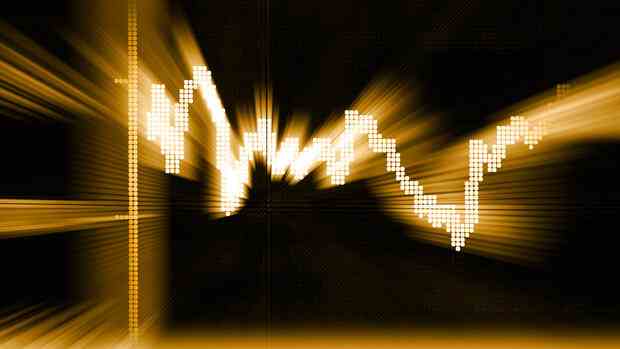Dusseldorf Investors on the German stock market are looking for new orientation these days. After a long period of very little impulse trading on Wednesday, the Dax slipped a bit in the afternoon. At the close of trading, the leading index was around 0.5 percent lower at 13,925 points. Today’s trading range is around 100 points.
Overall, the sideways trend of the past few days is continuing. As expected, trading volumes are extremely low these days. On Tuesday, a total of only 23 million pieces changed hands. This value is still far below the average for the period between Christmas 2021 and the following turn of the year (approx. 30 million).
It is primarily private investors who adjust their securities accounts after Christmas or use their free time to enter the market. The vast majority of professionals are keeping their books closed these days. With such a low trading volume, it only takes a comparatively small number of buyers or sellers to move prices in one direction.
The lack of orientation stands in the way: Not only are the professionals absent, there are also extremely few external influences. There are no relevant dates for the economy and companies on Wednesday.
Top jobs of the day
Find the best jobs now and
be notified by email.
Optimistic investors who nevertheless hoped for a year-end rally will be disappointed. Instead, the 14,000 point mark is proving to be extremely stubborn resistance.
Since the meeting of the Council of the European Central Bank (ECB) on December 15, the Dax has been hovering around this level without being able to sustainably overcome it, i.e. at the end of the day and on the following day. During this time, the barometer only managed to close over 14,000 meters on one day. The result shows a multi-day sideways movement with low trading volume.
In any case, the rise above 14,000 would now only be a drop in the bucket. The next important resistance is at 14,150 points. This is the lower limit of the several weeks of sideways movement before the ECB interest rate decision. For almost five weeks, the Dax fluctuated between almost 14,600 points on the top and just 14,150 points on the bottom. This support is now a key resistance.
>> Read here: What strategists expect for the Dax in 2023
Looking down is exciting. The area around 13,800 points is considered to be the relevant measure. This is the lowest level since mid-November. Recently, there has been sustained buying interest in this area.
Stock market expert Halver: “Shares are and will remain risky securities”
Of greater importance is the 200-day moving average, which reflects the average of the past 200 trading days and is used as a measure of the long-term trend in the stock market. It is currently at 13,565 points. After dynamic price increases, this mark is repeatedly tested.
In autumn, the Dax rose by almost 2700 points, and in the summer it also had a phase of several weeks with strong price increases. The 200-day line is currently rising in slow steps. It currently begins in mid-March and thus no longer reflects the first price reactions after the Russian invasion of Ukraine. Between mid-March and early May, the leading index was mostly above 14,000 points.
>> Read here: Which strategy you use to get dividend stocks in your portfolio
In the new stock market year, the 200-day line should then approach the price level in the Dax. This test is an important indicator for classifying the price increases since the end of September. If the Dax stays above the 200-day line, this speaks for a sustainable trend reversal and thus from a technical point of view for further rising prices. If it falls below this, this is to be interpreted as a sell signal.
Look at gold, oil and gas
gold remains above the $1800 a troy ounce mark despite slight losses. The precious metal is benefiting from the prospect of less stringent corona measures in China, which should boost demand. The hope that inflation has already peaked is also reflected in the price level. Gold has gained about 9 percent in value in the current quarter. At the beginning of November, a troy ounce cost $1,650.
the oil prices recorded losses of almost two percent in the middle of the week. Here, too, the relaxed corona measures in China had caused prices to rise. Prices rose to their highest level in three weeks on Tuesday. Now, however, the massive wave of infections in the country is fueling new concerns about a drop in demand.
Of the gas price reached its lowest level since the beginning of the war at 76.18. In the late afternoon, the futures are higher again, at around 83.50 euros per megawatt hour. This TTF contract often serves as a guide for the European price level. The recent mild weather has caused gas prices to fall significantly, by more than 50 euros since mid-December alone.
Look at individual values:
Porsche: Auto stocks are among the losers in Wednesday trading. Porsche preference and the shares of the holding close as well as Continental, Mercedes-Benz, BMW and Volkswagen all slightly in the red.
Telecom: The T-Share closes almost unchanged after a small interim gain. Analyst Mathieu Robilliard from the British investment bank Barclays had raised his target price from EUR 23.50 to EUR 25.00 and reiterated his “overweight” investment rating. The main reason for the target increase was that he had postponed the evaluation period for the telecom group further into the future.
Rheinmetall: The Düsseldorf-based group has received a major order worth 770 million euros for refrigerant compressors in the industrial sector. Rheinmetall announced on Wednesday that this was the largest single order in the non-military sector. The share, which is listed in the MDax, rose by 1.5 percent.
Here you can go to the page with the Dax course, here you can find the current tops & flops in the Dax.
